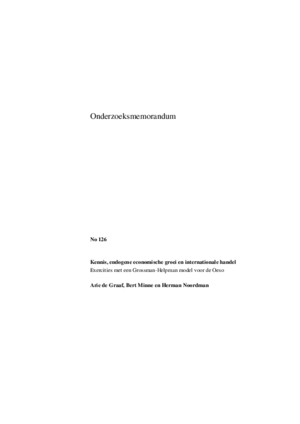Knowledge, endogenous economic growth and international trade; exercises with a Grossman-Helpman model for the OECD
Only recently have models emerged that explain this mechanism itself. In these Grossman-Helpman types of models, productivity is continuously improved because of the development of new knowledge in the form of blue-prints for new products. These models are usually extremely abstract and use simple production functions.
This paper will take such a model, enrich some of the production functions and apply it in an empirical way to a closed economy consisting of two trading countries (the Netherlands and the rest of the OECD).
First, we derive the model and choose values for the structural parameters. Technological development comes from generating new blue-prints. These are developed in a separate knowledge industry, which becomes more productive as the number of blue-prints increases. The intermediate goods industry buys these new blueprints and uses them to produce new intermediate products. This production takes place under monopolistic competition and the profits connected to this are the reason for investing in blue-prints. The intermediate goods are then used to produce, in a more productive manner, the final goods. Knowledge production leads to improved (labor)productivity in the final-goods industry.
This model simulates the impact of four different shifts in exogenous variables: 1) more efficient knowledge-production, 2) better substitution between skilled and unskilled workers, 3) more market power of product innovators and 4) a shift from unskilled to skilled workers. For each impulse, we indicate what kind of economic policy might result in such a shift. We discuss the results, focusing on explaining by which mechanisms the impulses lead to the final results. We also discuss the cumulative impulse and perform a sensitivity analysis.
This document is only available in Dutch.
